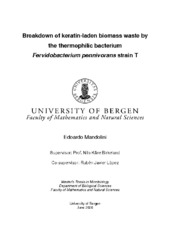| dc.description.abstract | Developing a more sustainable agro-industry has become a necessity in light of the current environmental crisis. Biocatalysts are already adopted in many industrial applications and have quickly optimized, and in some cases replaced, existing biochemical reactions within the modern agro-industry. Extremozymes, in particular, are valuable tools for processes requiring harsh industrial conditions where, for example, increased temperature may be beneficial for the bioavailability and solubility of organic compounds as well as for improvement in degradation of substrates. In this regard, alternatives to landfill disposal or incineration of keratinous materials such as feathers, wool, hides, hair etc. are emerging and efforts in exploiting thermo-stable keratinolytic biocatalysts have been attempted. Nonetheless, keratin degradation remains a complex process poorly understood and thus limiting the current toolbox of useful enzymes and organisms needed to meet all demands. In this study, a newly isolated strain of an anaerobic, thermophilic microorganism belonging to the Thermotogae phylum, Fervidobacterium pennivorans strain T, was assessed for its capability of degrading native chicken feathers. By following a multiomics approach, its proteolytic system was explored in the attempt to isolate new keratinase candidates. First, the physiology of F. pennivorans strain T was further investigated in batch cultures and the first growth curve of an organism of this species was described, showing a generation time of 150 minutes and a long stationary phase. Then, the complete genome of the organism was sequenced and analysed, revealing interesting molecular features, such as inverted genomic blocks, when compared to its most closely related organisms: F. pennivorans DSM9078T and F. islandicum AW-1. The strain T genome was slightly shorter (2002515 base pair) and had ANI values of 97.65 % and 80.90% to the compared organisms, respectively, but the same number of predicted protease-encoding genes (55) were found by gene mining analysis. Next, feather degradation by the organism was up-scaled using a bioreactor to further evaluate its potential in industrial applications and cells were sampled for transcriptomics purposes. F. pennivorans strain T performed mediocrely in the fermenter, but RNA extraction was, however, not successful. From secretomics analysis of growing cultures, an extracellular serine protease named Peg_1025 was identified, showing high sequence conservation with the subtilisin type proteases, especially with subtilisin Ak1 from Geobacillus stearothermophilus strain AK1. By multiple sequencing alignment, the catalytic triad His, Asp, Ser, as well as a signal peptide and a propeptide domain were predicted. Three dimensional structural modelling using subtilisin Ak1 as template, showed Peg_1025 to possess several insertions of unknown functions compared to subtilisin Ak1, only one conserved Ca2+ binding site as well as lack of a disulphide bond in the active cleft. Nonetheless, important structural motifs remained conserved. The enzyme was successfully expressed in E. coli using N- and C-terminal His-tag and soluble proteins were active at 70°C in proteolytic activity assays that used casein as substrate. Phylogenetic analyses revealed that Peg_1025 belongs to a distinct clade of Thermotogae peptidases separated from fervidolysin and Ak1, and as such, it represents the first characterized member of this phylogenetic group. Although the specific role of the serine protease in feather degradation remains unclear, the general results from this study confirm that F. pennivorans strain T possesses a complex machinery with keratinolytic power. The biology of this extremophile remains an intriguing field of exploration, further encouraged by its biotechnological potential that is still left to unfold. | en_US |
